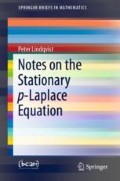Abstract
The modern theory of viscosity solutions was developed by Crandall, Evans, Jensen, Ishii, Lions, and others. First, it was designed for first order equations. Later, it was extended to second order equations. The solutions must obey a Comparison Principle.
Access this chapter
Tax calculation will be finalised at checkout
Purchases are for personal use only
Notes
- 1.
A few chapters from [K] are enough for our purpose.
- 2.
Here the word “viscosity” is only a label. It comes from the method of vanishing viscosity. In our case one would replace \(\Delta _pu=0\) by \(\Delta _pu_{\varepsilon }+\varepsilon \Delta u_{\varepsilon } = 0\) and send \(\varepsilon \) to zero, so that the artificial viscosity term \(\varepsilon \Delta u_{\varepsilon }\) vanishes. So \(\lim u_{\varepsilon } = u\) is reached. Properly arranged, this is the same concept.
- 3.
It is also sufficient provided that the closures \(\overline{J^{2,-}v}\) of the subjets are evoked. See [K].
- 4.$$\begin{aligned}&\int \!|\nabla v -\nabla v_{\varepsilon }|^p\, dx\\ =&\int \!|\nabla v -\nabla v_{\varepsilon }|^p\bigl (1+|\nabla v|^2+|\nabla v_{\varepsilon }|^2\bigr )^{p(p-2)/4} \bigl (1+|\nabla v|^2+|\nabla v_{\varepsilon }|^2\bigr )^{p(2-p)/4}\, dx\\ \le&\Bigl \{\int \!|\nabla v -\nabla v_{\varepsilon }|^2\bigl (1+|\nabla v|^2+|\nabla v_{\varepsilon }|^2\bigr )^{(p-2)/2}\Bigr \}^{\frac{p}{2}}\Bigl \{\int \!\bigl (1+|\nabla v|^2+|\nabla v_{\varepsilon }|^2\bigr )^{p/2}\, dx\Bigr \}^{1-\frac{p}{2}}\\ \le&\Bigl \{\tfrac{1}{p-1}\int \!\langle |\nabla v|^{p-2}\nabla v - |\nabla v_{\varepsilon }|^{p-2}\nabla v_{\varepsilon },\nabla v -\nabla v_{\varepsilon }\rangle \, dx\Bigr \}^{\frac{p}{2}}\Bigl \{\int \!\bigl (1+|\nabla v|^2+|\nabla v_{\varepsilon }|^2\bigr )^{p/2}\, dx\Bigr \}^{\frac{2-p}{2}} \end{aligned}$$
where inequality (VII) in Sect. 12 was used at the last step.
Author information
Authors and Affiliations
Corresponding author
Rights and permissions
Copyright information
© 2019 The Author(s), under exclusive license to Springer Nature Switzerland AG
About this chapter
Cite this chapter
Lindqvist, P. (2019). Viscosity Solutions. In: Notes on the Stationary p-Laplace Equation. SpringerBriefs in Mathematics. Springer, Cham. https://doi.org/10.1007/978-3-030-14501-9_9
Download citation
DOI: https://doi.org/10.1007/978-3-030-14501-9_9
Published:
Publisher Name: Springer, Cham
Print ISBN: 978-3-030-14500-2
Online ISBN: 978-3-030-14501-9
eBook Packages: Mathematics and StatisticsMathematics and Statistics (R0)

